Abstract
:1. Introduction
2. Material and Methods
2.1. RegCM4 Configuration and Experiment Design
2.2. Analysis
3. Results
3.1. Validation of the Simulated Climatology in CTRL
3.2. Effects of Deforestation
3.3. Water Balance: CTRL vs. LUC Experiments
4. Conclusions
Acknowledgments
Author Contributions
Conflicts of Interest
Abbreviations
| AMZ | Amazon |
| CONV | convective precipitation |
| CTRL | simulation with Amazon forest |
| ET | evapotranspiration |
| G | soil heat fluxes |
| H | sensible heat |
| LE | latent heat |
| LUC | simulation change to the Amazon forest by grass |
| P | precipitation |
| Rn | net surface radiation |
| q | specific humidity in air |
| C | moisture convergence |
References
- Programa das Nações Unidas para o Meio Ambiente (PNUMA); Organização do Tratado de Cooperação Amazônica (OTCA); Centro de Pesquisa da Universidad del Pacifico (CUIP). Perspectivas do Meio Ambiente na Amazônia—GeoAmazônia, Panamá-Brasil-Peru; United Nations Environment Program (UNEP): Panama City, Panama, 2008. (In Portuguese) [Google Scholar]
- Andersen, L.E.; Granger, C.W.J.; Reis, E.J.; Weinhold, D.; Wunder, S. The Dynamics of Deforestation and Economic Growth in the Brazilian Amazon; Cambridge University Press: Cambridge, UK, 2002. [Google Scholar]
- INPE. PRODES—Amazon Deforestation Database; INPE: São Jose dos Campos, Brazil, 2010; Available online: www.obt.inpe.br/prodes (accessed on 20 September 2017).
- Dias, L.C.P.; Pimenta, F.M.; Santos, A.B.; Costa, M.H.; Ladle, R.J. Patterns of land use, extensification and intensification of Brazilian agriculture. Glob. Chang. Biol. 2016, 22, 2887–2903. [Google Scholar] [CrossRef] [PubMed]
- Culf, A.D.; Esteves, J.L.; Marques Filho, A.d.O.; da Rocha, H.R. Radiation, temperature and humidity over forest and pasture in Amazonia. In Amazonian Deforestation and Climate; Gash, J.H.C., Ed.; John Wiley: New York, NY, USA, 1996; pp. 175–191. [Google Scholar]
- Eltahir, E.A.B. Role of vegetation in sustaining large-scale atmospheric circulations in the tropics. J. Geophys. Res. 1996, 101, 4255–4268. [Google Scholar] [CrossRef]
- Gash, J.H.C.; Nobre, C.A. Climatic effects of Amazonian deforestation: Some results from ABRACOS. Bull. Am. Meteorol. Soc. 1997, 78, 823–830. [Google Scholar] [CrossRef]
- Pearson, T.R.H.; Brown, S.; Murray, L.; Sidman, G. Greenhouse gas emissions from tropicalforest degradation: an underestimated source. Carbon Balance Manag. 2017, 12, 3–11. [Google Scholar] [CrossRef] [PubMed]
- Costa, M.H.; Foley, J.A. Combined effects of deforestation and doubled atmospheric CO2 concentrations on the climate of Amazonia. J. Clim. 2000, 13, 18–34. [Google Scholar] [CrossRef]
- Pielke, R.; Pitman, A.; Niyogi, D.; Mahmood, R.; Mcalpine, C.; Hossain, F.; Goldewijk, K.K.; Nair, U.; Betts, R.; Fall, S.; et al. Land use/land cover changes and climate: Modeling analysis and observational evidence. WIREs Clim. Chang. 2011, 2, 828–850. [Google Scholar] [CrossRef]
- Brubaker, K.L.; Entekhabi, D.; Eagleson, P.S. Estimation of continental precipitation recycling. J. Clim. 1993, 6, 1077–1089. [Google Scholar] [CrossRef]
- Llopart, M.; Coppola, E.; Giorgi, F.; Da Rocha, R.P.; Cuadra, S.V. Climate change impact on precipitation for the Amazon and La Plata basins. Clim. Chang. 2014, 125, 111–125. [Google Scholar] [CrossRef]
- Gimeno, L.; Drumond, A.; Nieto, R.; Trigo, R.M.; Stohl, A. On the origin of continental precipitation. Geophys. Res. Lett. 2010, 37. [Google Scholar] [CrossRef]
- Durán-Quesada, A.M.; Reboita, M.S.; Gimeno, L. Precipitation in tropical America and the associated sources of moisture: A short review. Hydrol. Sci. J. 2012, 57, 1–13. [Google Scholar] [CrossRef]
- Drumond, A.; Marengo, J.; Ambrizzi, T.; Nieto, R.; Moreira, L.; Gimeno, L. The role of Amazon basin moisture on the atmospheric branch of the hydrological cycle: A Lagrangian analysis. Hydrol. Earth Syst. Sci. 2014, 18, 2577–2598. [Google Scholar] [CrossRef] [Green Version]
- Eltahir, E.A.B.; Bras, R.L. Precipitation recycling in the Amazon basin. Q. J. R. Meteorol. Soc. 1994, 120, 861–880. [Google Scholar] [CrossRef]
- Nobre, C.A.; Sellers, P.J.; Shukla, J. Amazonian deforestation and regional climate change. J. Clim. 1991, 4, 957–988. [Google Scholar] [CrossRef]
- Werth, D.; Avissar, R. The local and global effects of Amazon deforestation. J. Geophys. Res. 2002, 107, 8087. [Google Scholar] [CrossRef]
- Brankovic, C.; Molteni, F.; Viterbo, P. GCM sensitivity experiments with locally modified land surface propertiesover tropical South America. Clim. Dyn. 2006, 26, 729–749. [Google Scholar] [CrossRef]
- Salazar, L.F.; Nobre, C.A.; Oyama, M.D. Climate change consequences on the biome distribution in tropical South America. Geophys. Res. Lett. 2007, 34, L09708. [Google Scholar] [CrossRef]
- Gandu, A.W.; Cohen, J.C.P.; de Souza, J.R.S. Simulation of deforestation in eastern Amazonia using a high-resolution model. Theor. Appl. Climatol. 2004, 78, 123–135. [Google Scholar] [CrossRef]
- Correia, F.W.S.; Alvalá, R.C.S.; Manzi, A.O. Modeling the impacts of land cover change in Amazonia: A regional climate model (RCM) simulation study. Theor. Appl. Climatol. 2008, 93, 225–244. [Google Scholar] [CrossRef]
- Salazar, L.F.; Nobre, C.A. Climate change and thresholds of biome shifts in Amazonia. Geophys. Res. Lett. 2010, 37, L17706. [Google Scholar] [CrossRef]
- Lejeune, Q.; Davin, E.L.; Guillod, B.P.; Seneviratne, S.I. Influence of Amazonian deforestation on the future evolution of regional surface fluxes, circulation, surface temperature and precipitation. Clim. Dyn. 2015, 44, 2769–2786. [Google Scholar] [CrossRef]
- Silva, M.E.S.; Pereira, G.; da Rocha, R.P. Local and remote climatic impacts due to land use degradation in the Amazon “Arco f Deforestation”. Theor. Appl. Climatol. 2016, 125, 609–623. [Google Scholar] [CrossRef]
- Giorgi, F.; Coppola, E.; Solmon, F.; Mariotti, L.; Sylla, M.B.; Bi, X.; Elguindi, N.; Diro, G.T.; Nair, V.; Giuliani, G.; et al. RegCM4: Model description and preliminary tests over multiple CORDEX domains. Clim. Res. 2012, 52, 7–29. [Google Scholar] [CrossRef]
- Pal, J.S.; Giorgi, F.; Bi, X.; Elguindi, N.; Solmon, F.; Rauscher, S.A.; Gao, X.; Francisco, R.; Zakey, A.; Winter, J.; et al. Regional climate modeling for the developing world: The ICTP RegCM3 and RegCNET. Bull. Am. Meteorol. Soc. 2007, 88, 1395–1409. [Google Scholar] [CrossRef]
- Grell, G.A. Prognostic evaluation of assumptions used by cumulus parameterizations. Mon. Weather Rev. 1993, 121, 764–787. [Google Scholar] [CrossRef]
- Emanuel, K.A.; Zivkovic-Rothman, M. Development and evaluation of a convection scheme for use in climate models. J. Atmos. Sci. 1999, 56, 1766–1782. [Google Scholar] [CrossRef]
- Oleson, K.W.; Lawrence, D.M.; Bonan, G.B.; Drewniak, B.; Huang, M.; Koven, C.D.; Levis, S.; Li, F.; Riley, W.J.; Subin, Z.M.; et al. Technical Description of Version 4.5 of the Community Land Model (CLM); NCAR Technical Note NCAR/TN-503+STR; National Center for Atmospheric Research: Boulder, CO, USA, 2013; 434 p. [Google Scholar]
- Dickinson, R.E.; Henderson-Sellers, A.; Kennedy, P.J. Biosphere–Atmosphere Transfer Scheme (BATS) Version 1e as Coupled to the NCAR Community Model; NCAR Technical Note NCAR/TN-3871STR; National Center for Atmospheric Research: Boulder, CO, USA, 1993; 72 p. [Google Scholar]
- Loveland, T.R.; Reed, B.C.; Brown, J.F.; Ohlen, D.O.; Zhu, Z.; Yang, L.; Merchant, J.W. Development of a global land cover characteristics database and IGBP DISCover from 1 km AVHRR data. Int. J. Remote Sens. 2000, 21, 1303–1365. [Google Scholar] [CrossRef]
- Giorgi, F.; Jones, C.; Asrar, G.R. Addressing climate information needs at the regional level: The CORDEX framework. WMO Bull. 2009, 58, 175–183. [Google Scholar]
- Dee, D.P.; Uppala, S.; Simmons, A.; Berrisford, P.; Poli, P.; Kobayashi, S.; Andrae, U.M.; Balmaseda, A.; Balsamo, G.; Bauer, P.; et al. The ERA-Interim reanalysis: Configuration and performance of the data assimilation system. Q. J. R. Meteorol. Soc. 2011, 137, 553–597. [Google Scholar] [CrossRef]
- Reboita, M.S.; Fernandez, J.P.R.; Llopart, M.; da Rocha, R.P.; Pampuch, L.; Cruz, F.T. Assessment of RegCM4.3 over the CORDEX South America Domain: Sensitivity Analysis to Physical Parameterization Scheme. Clim. Res. 2014, 60, 215–234. [Google Scholar] [CrossRef]
- Llopart, M.; da Rocha, R.P.; Reboita, M.S.; Cuadra, S.V. Sensitivity of simulated South America climate to the land surface schemes in RegCM4. Clim. Dyn. 2017, 49, 3975. [Google Scholar] [CrossRef]
- Brohan, P.; Kennedy, J.J.; Harris, I.; Tett, S.F.B.; Jones, P.D. Uncertainty estimates in regional and global observed temperature changes: A new dataset from 1850. J. Geophys. Res. 2006, 111, D12106. [Google Scholar] [CrossRef]
- Hartmann, D.L. Global Physical Climatology; Academic Press: New York, NY, USA, 1994. [Google Scholar]
- Nascimento, M.G.; herdies, D.L.; Souza, D.O. The South American Water Balance: The Influence of Low-Level Jets. J. Clim. 2016, 39, 1429–1449. [Google Scholar] [CrossRef]
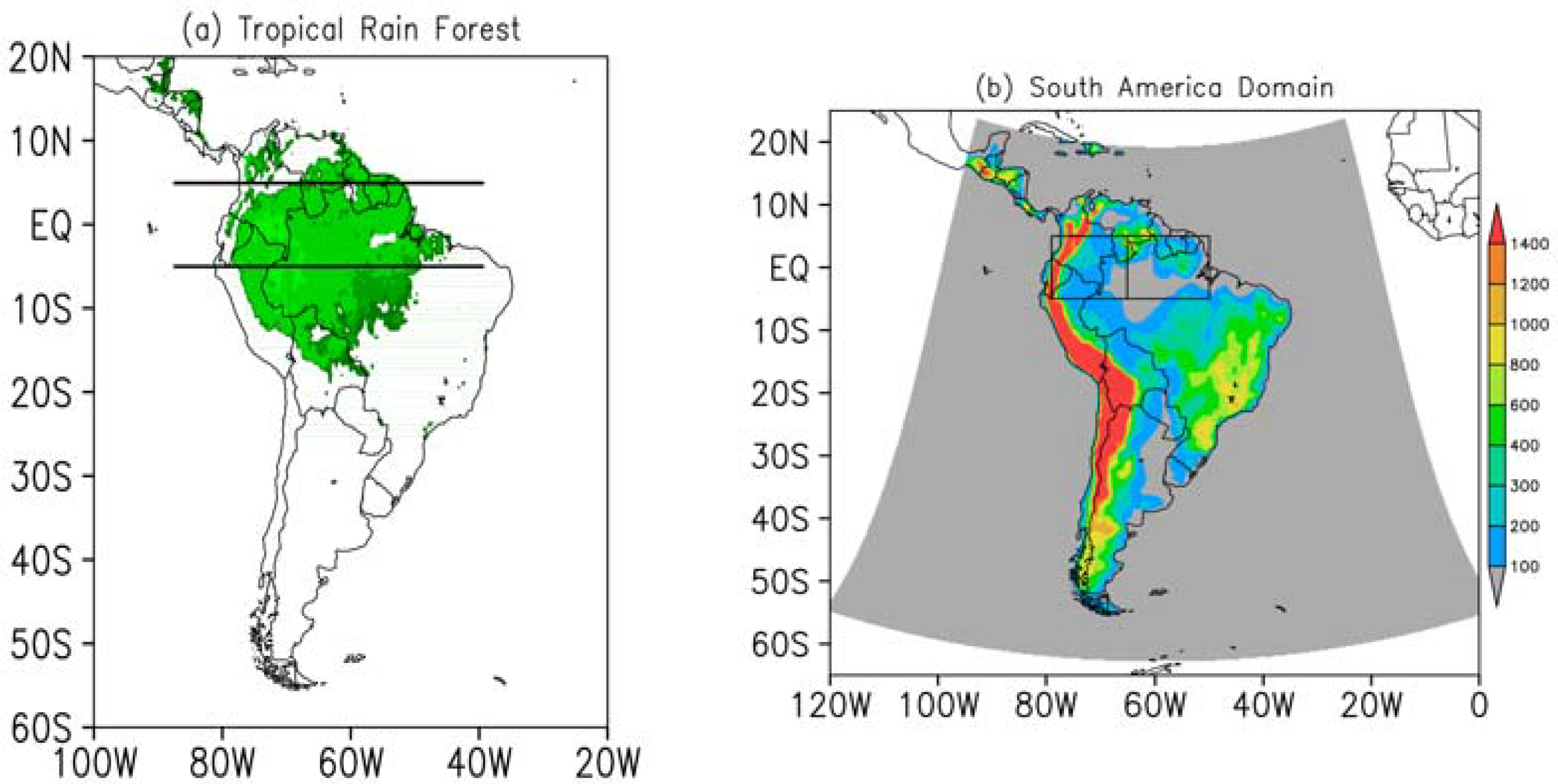
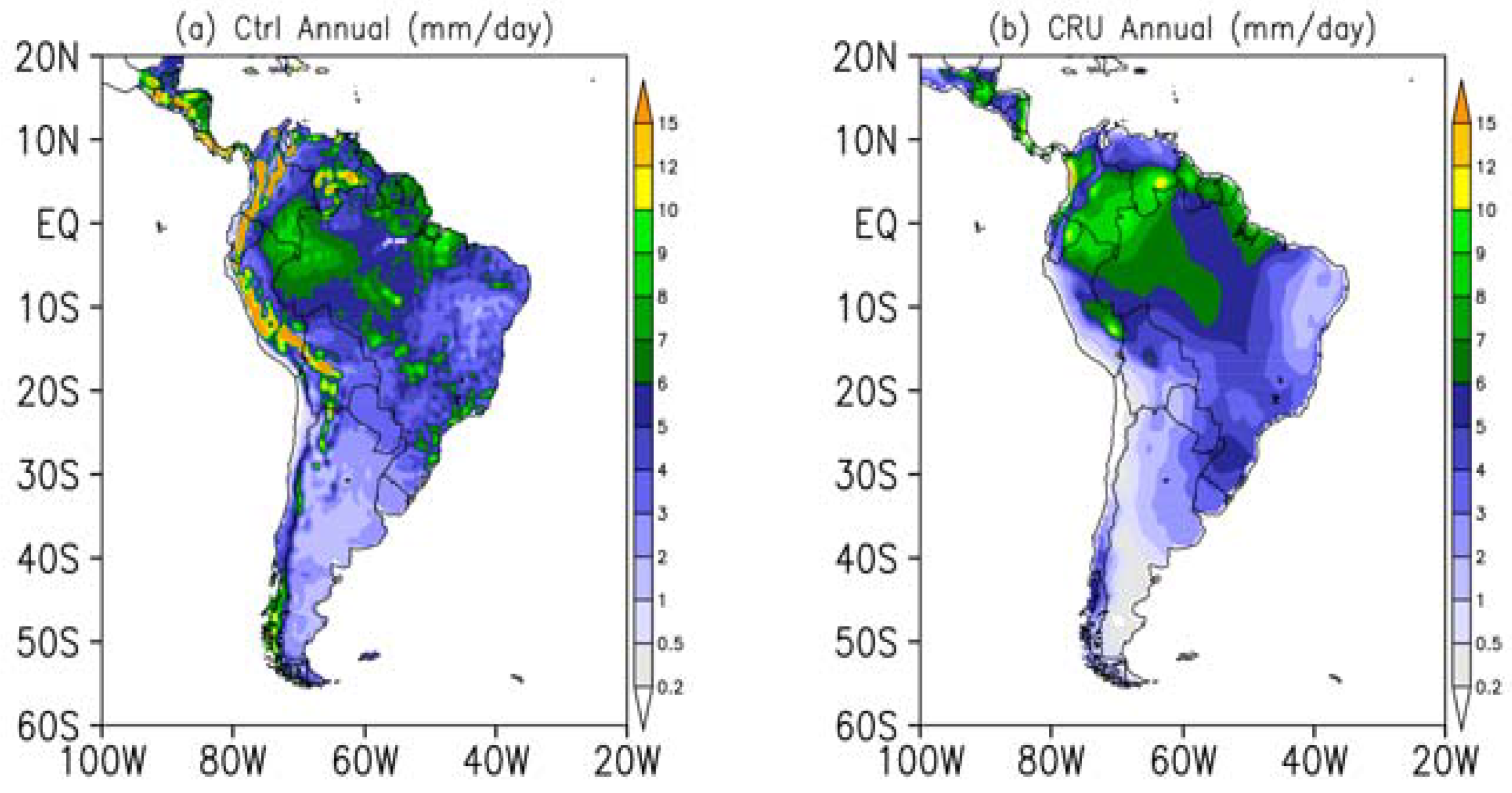
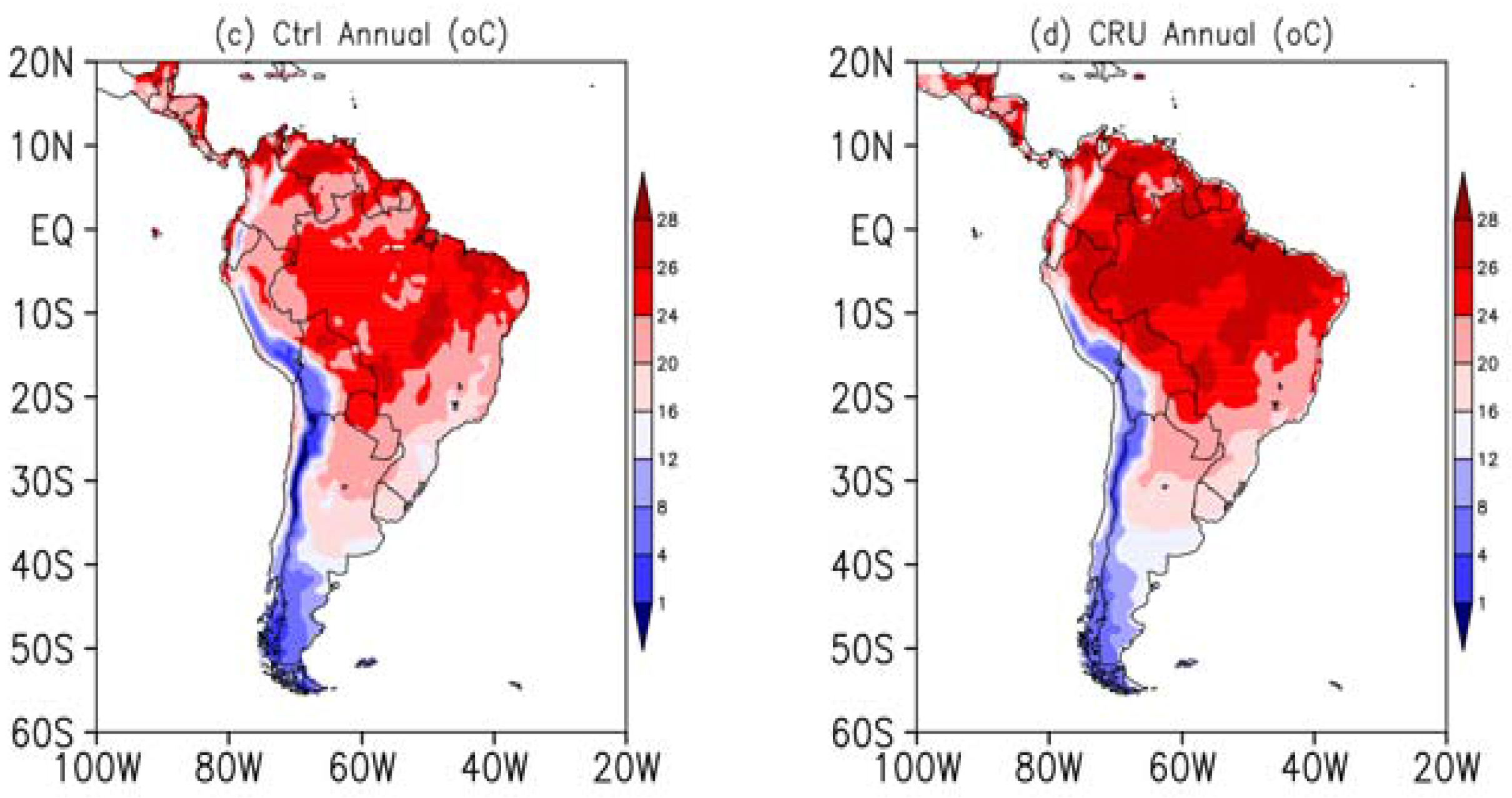
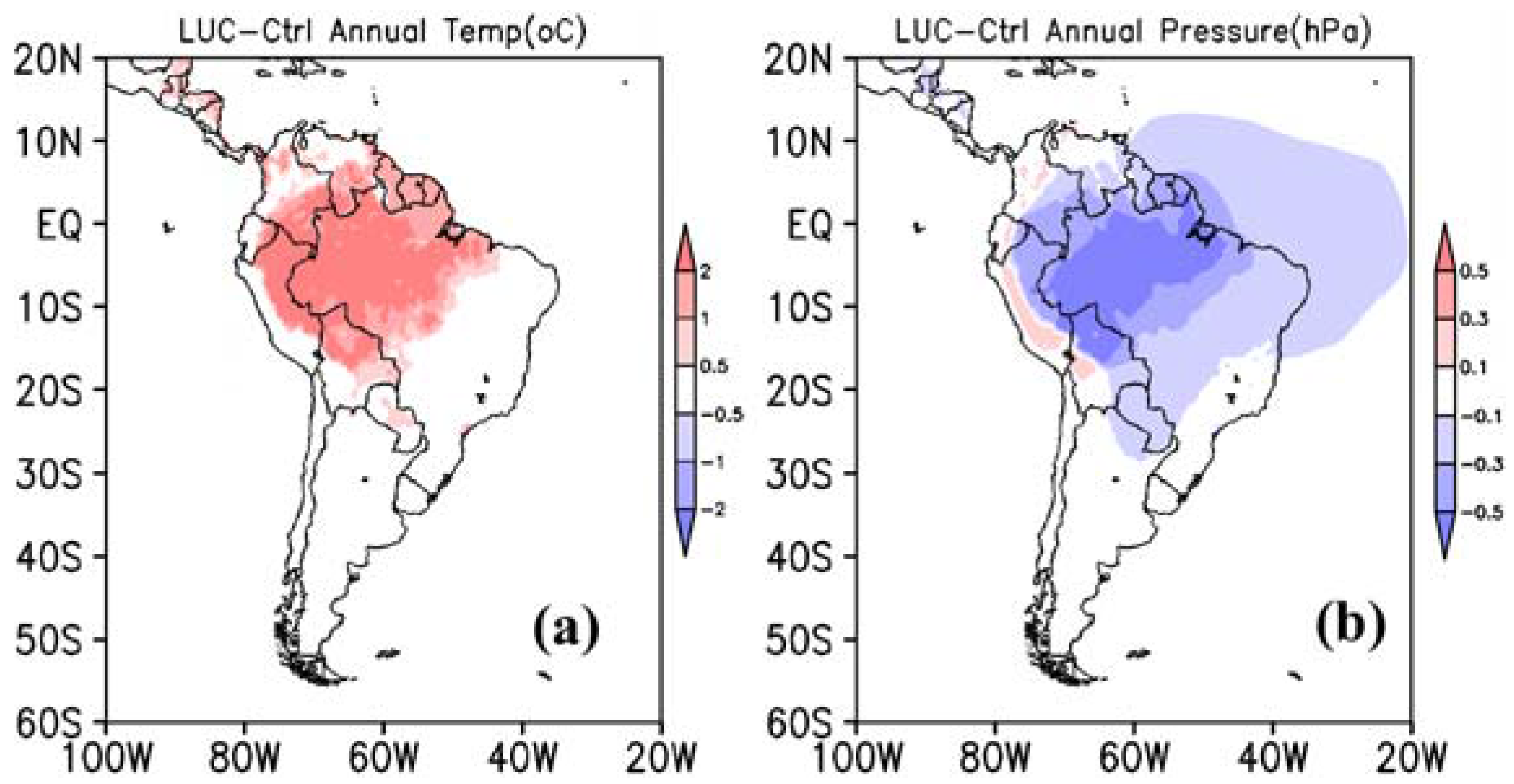
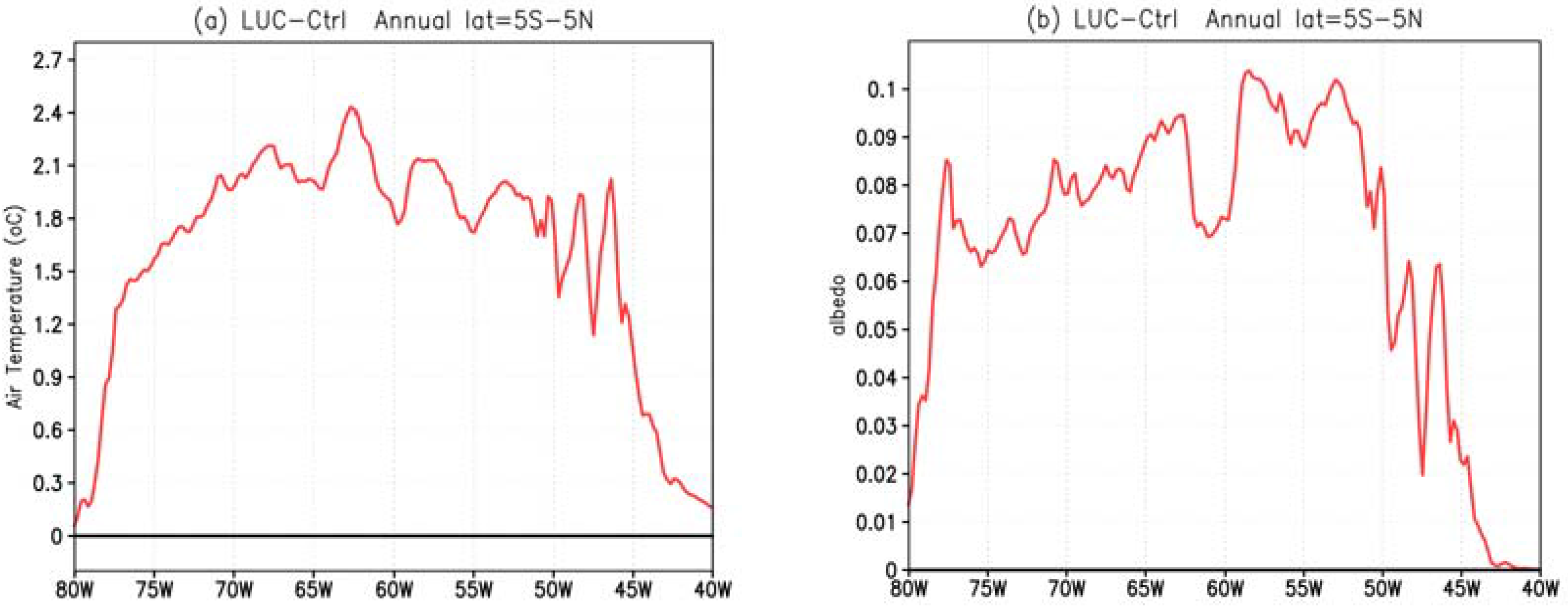
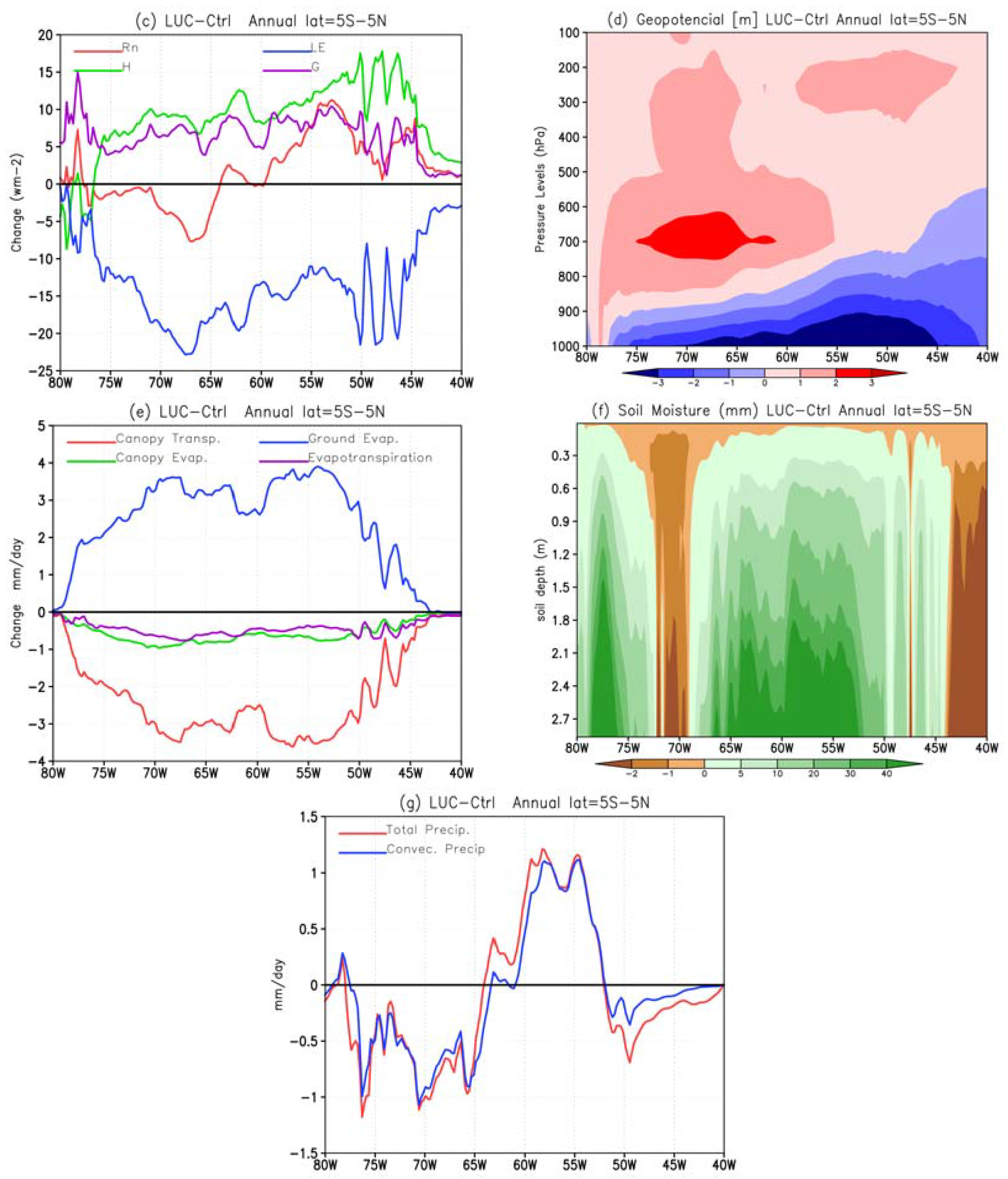
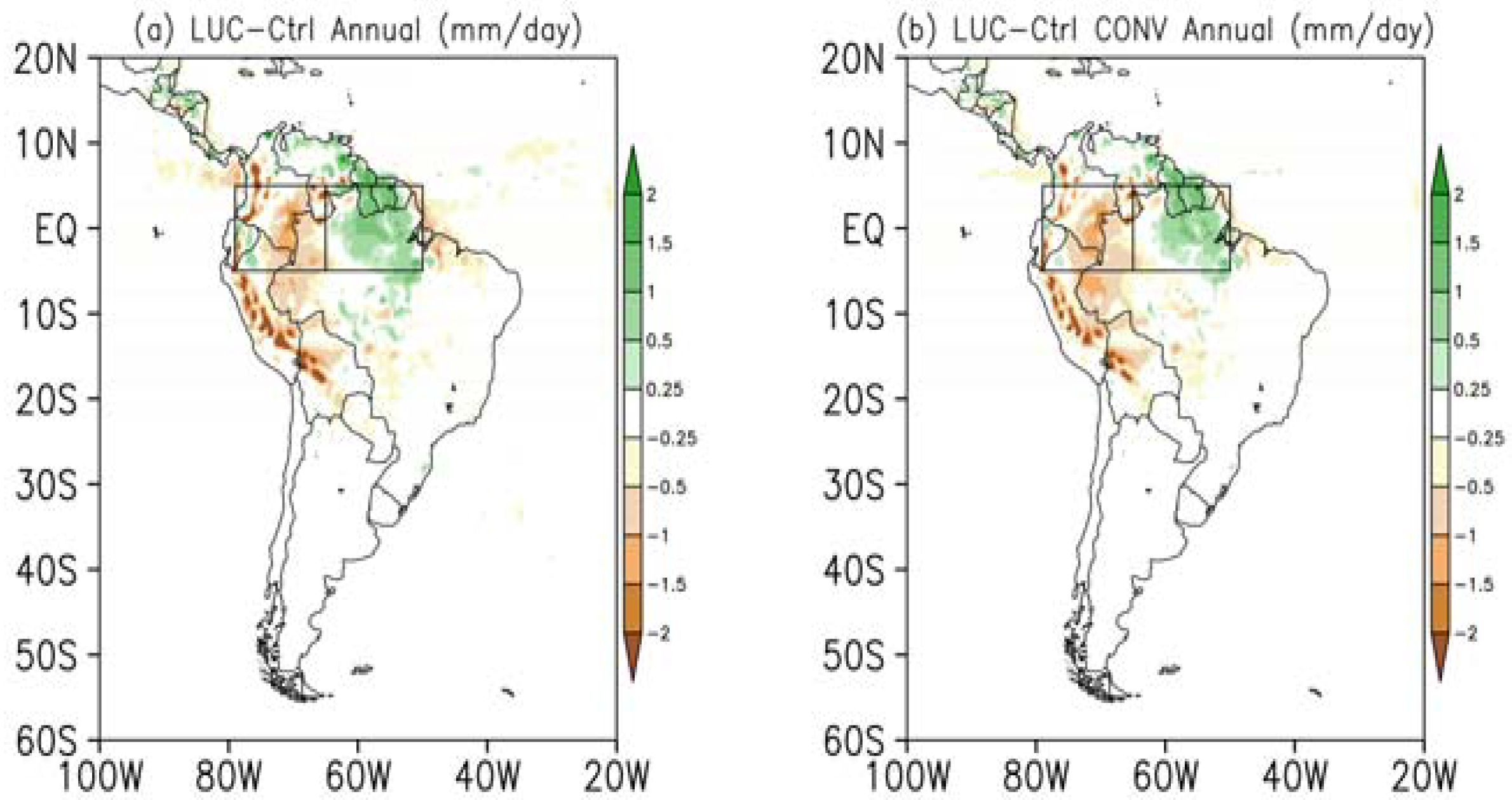
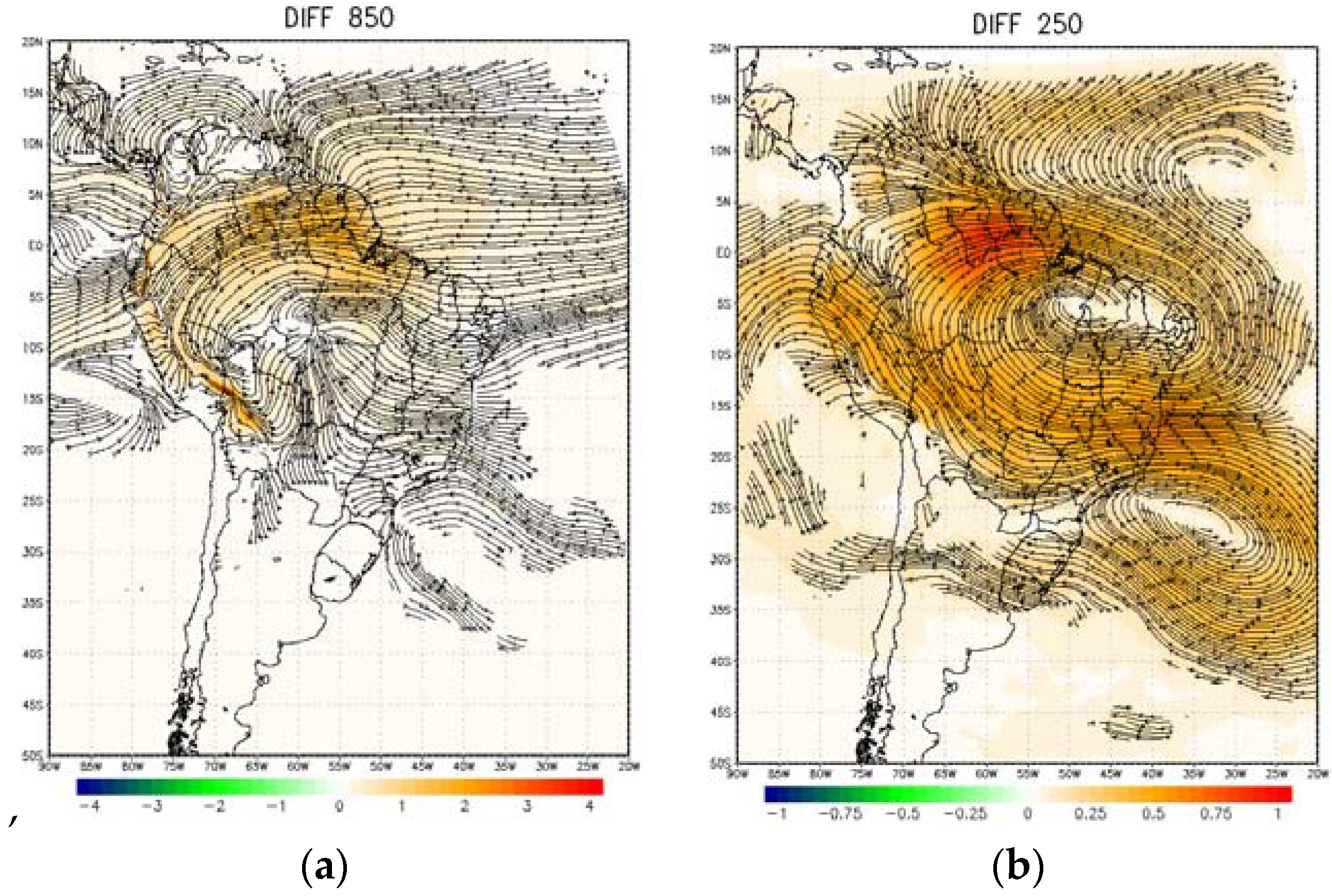
| Water Balance Components | Western AMZ (Decrease of Precipitation) | Eastern AMZ (Increase of Precipitation) | ||||
|---|---|---|---|---|---|---|
| CTRL | LUC | LUC-CTRL | CTRL | LUC | LUC-CTRL | |
| P | 7.31 | 6.73 | −0.58 | 6.05 | 6.52 | 0.47 |
| ET | 4.20 | 3.70 | −0.50 | 4.60 | 4.00 | −0.60 |
| C | −2.20 | −2.40 | −0.20 | −2.10 | −3.20 | −1.10 |
© 2018 by the authors. Licensee MDPI, Basel, Switzerland. This article is an open access article distributed under the terms and conditions of the Creative Commons Attribution (CC BY) license (http://creativecommons.org/licenses/by/4.0/).
Share and Cite
Llopart, M.; Reboita, M.S.; Coppola, E.; Giorgi, F.; Da Rocha, R.P.; De Souza, D.O. Land Use Change over the Amazon Forest and Its Impact on the Local Climate. Water 2018, 10, 149. https://doi.org/10.3390/w10020149
Llopart M, Reboita MS, Coppola E, Giorgi F, Da Rocha RP, De Souza DO. Land Use Change over the Amazon Forest and Its Impact on the Local Climate. Water. 2018; 10(2):149. https://doi.org/10.3390/w10020149
Chicago/Turabian StyleLlopart, Marta, Michelle Simões Reboita, Erika Coppola, Filippo Giorgi, Rosmeri Porfírio Da Rocha, and Diego Oliveira De Souza. 2018. "Land Use Change over the Amazon Forest and Its Impact on the Local Climate" Water 10, no. 2: 149. https://doi.org/10.3390/w10020149





